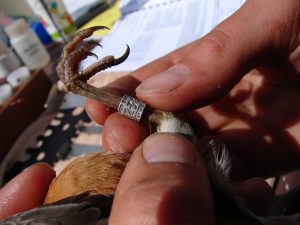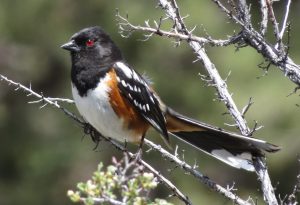SCIENCE BRIEF: BLACK TERN POPULATION DECLINES — KLAMATH BIRD OBSERVATORY SCIENCE IN THE CONTEXT OF WATER USE AND WETLAND CONSERVATION IN THE KLAMATH BASIN

In Part Two of a three-part series on the wildlife refuges of the Klamath Basin and water in the arid West, reporter Jes Burns puts KBO research and monitoring results in the broader context of bird population declines in the Upper Klamath Basin. Click here to read and listen to the Oregon Public Broadcast series.
The following provides more detailed information about KBO’s Black Tern monitoring results:
10 YEAR STUDY FINDS SHARP DECLINE IN BLACK TERNS – POSSIBLE TIE TO WATER MANAGEMENT IN THE KLAMATH BASIN
Results from long-term monitoring efforts show that Black Tern population declines in the Klamath Basin are higher than declines previously documented for continental and regional populations. Results from a 10 year study conducted by Klamath Bird Observatory show a steady, sharp decline in numbers of Black Terns in the wetlands and open waters of Agency Lake and Upper Klamath Lake.
Klamath Bird Observatory Science Director and the study’s lead author Jaime Stephens points out, “Black Tern populations in North America experienced steep declines prior to 1980, likely a result of dramatic wetland habitat loss. The current population is estimated to be about one-third of its historical size — reversing declines has become a conservation priority. Our findings suggest an alarming decline of 8% loss annually at Agency and Upper Klamath Lakes.”
According to a Black Tern conservation plan created in 2006, the desired population objective within the Great Basin — which includes the Klamath Basin — is 10,000 individuals. The current estimate of Black Terns for this area is already some 20% below the objective, making these local declines a red flag. The 2006 Intermountain West Waterbird Conservation Plan was created by many researchers from multiple organizations and agencies to identify and fill knowledge gaps and aid in all-bird conservation efforts. Conservation plans are developed by looking at historic and current population numbers to create reasonable objectives for maintaining populations with the goal of avoiding costly special-protection actions such as threatened or endangered species listing.
Terns are migratory waterbirds related to gulls. Many tern species travel to inland waterbodies to nest and return to coastal areas for most of the year. The Black Tern is one of the smallest terns in the world with a graceful, floating flying appearance. It is a long-distance migrant, nesting in wetlands across the northern United States and southern Canada and wintering along South America’s northern coasts. Black Tern long-term population declines have been attributed degradation and loss of wetland habitat across North America. Now studies must focus on existing habitat suitability, including water levels and water quality.
Klamath Basin National Wildlife Refuge Complex manager Greg Austin said, “We find these results reflective of the declines observed in wetland habitat throughout the Klamath Basin. Historically the refuges provided the necessary habitats to support Black Tern populations, however with the loss of wetland habitat throughout the Klamath Basin Black Tern populations have declined. The Klamath Basin is an over-allocated system; drought and increased demands on water resources have put the Klamath Basin out of balance; there is not enough water to completely satisfy every need every year. A balanced approach for water allocation in the Basin is needed for effective management by all stakeholders”.
KBO’s Stephens explained the importance of this study’s results: “It is not well understood how water levels in the Klamath Basin relate to how much Black Tern breeding season habitat is available and how good that habitat is for raising young. Given the challenges that Black Terns face from a combination of water allocation, drought, and climate change impacts, an improved understanding local habitat needs is pressing.”
She added: “The best next step to addressing local Black Tern population loss is to determine the cause of the decline we found.”
The results of the 2001-2010 Klamath Basin Black Tern study were published in the Winter 2015 issue of the Northwest Naturalist journal. To read or download the publication click here.
###
Klamath Bird Observatory, based in Ashland, Oregon, is a scientific non-profit organization that achieves bird conservation in the Pacific Northwest and throughout the migratory ranges of the birds of our region. We developed our award-winning conservation model in the ruggedly beautiful and wildlife-rich Klamath-Siskiyou Bioregion of southern Oregon and northern California, and we now apply this model more broadly to care for our shared birds throughout their annual cycles. Emphasizing high caliber science and the role of birds as indicators of the health of the land, we specialize in cost-effective bird monitoring and research projects that improve natural resource management. Also, recognizing that conservation occurs across many fronts, we nurture a conservation ethic in our communities through our outreach and educational programs.
Media Contact: Jaime Stephens, Science Director
Klamath Bird Observatory
541-201-0866 x 2#
jlh [AT] klamathbird.org






 The registration deadline has been extended for Klamath Bird Observatory’s July 24-28 Fundamentals of Songbird Banding Workshop – now July 12.
The registration deadline has been extended for Klamath Bird Observatory’s July 24-28 Fundamentals of Songbird Banding Workshop – now July 12. 

 I glance up haphazardly thru thin trees, binoculars in hand, looking for winged activity. My eyes meet a fierce stare only a few feet above me. I freeze in place hoping to not cause this little hunter to flush. Two small golden eyes, surrounded by spotted feathers forming a disc shape on either side of a pale hooked beak, are the features I notice immediately. How long have you been watching me, I ask myself? Like so many forest dwellers I’m certain its detection is easily ten-times my own and has in all likelihood noticed my fellow bird surveyors and me for some time already.
I glance up haphazardly thru thin trees, binoculars in hand, looking for winged activity. My eyes meet a fierce stare only a few feet above me. I freeze in place hoping to not cause this little hunter to flush. Two small golden eyes, surrounded by spotted feathers forming a disc shape on either side of a pale hooked beak, are the features I notice immediately. How long have you been watching me, I ask myself? Like so many forest dwellers I’m certain its detection is easily ten-times my own and has in all likelihood noticed my fellow bird surveyors and me for some time already. Zoomed in I notice its feather pattern more so—in profile I see tiny feathers protruding between the eyes and beak. Its rusty dark brown plumage resembles the bark color of incense cedar. But it’s the false eyes that really capture me. Unlike the wide and round real ones, these black and white feathered patterns are narrowed and angry. Both pairs seem to be constantly searching, watching, scanning; this pint-size predator transfixes me.
Zoomed in I notice its feather pattern more so—in profile I see tiny feathers protruding between the eyes and beak. Its rusty dark brown plumage resembles the bark color of incense cedar. But it’s the false eyes that really capture me. Unlike the wide and round real ones, these black and white feathered patterns are narrowed and angry. Both pairs seem to be constantly searching, watching, scanning; this pint-size predator transfixes me.